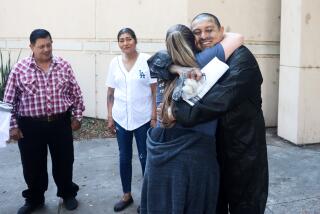O.C. Hospital Acts to End Baby Mix-Ups
Admitting widespread problems in the maternity ward, the president of St. Joseph Hospital said Monday that the hospital will buy an electronic security system to ensure that a newborn is never again sent home with the wrong parents.
The announcement came in the wake of revelations that the Valentine’s Day baby switch--in which a Tustin couple left the Orange hospital with a child who did not belong to them--was not an isolated incident as was first believed, President Larry Ainsworth said, but part of a “systemic problem.”
Ainsworth said he felt “nauseated” by news that such mistakes had been made at his hospital, calling the Valentine’s Day mix-up “every parent’s nightmare.”
“Clearly, we have a problem in our mother/child unit,” Ainsworth said.
Nurses mixed up babies at least three additional times in the last year, hospital officials said, although all the mistakes were straightened out before the babies left the hospital. The most serious case involved a mother breast-feeding the wrong infant for 30 minutes.
The hospital is under investigation by state medical officials for the baby switches, and investigators from the Department of Health Services spent much of Monday in the hospital’s maternity ward. But hospital officials defended their earlier decision not to report those problems to the state, saying the errors did not meet the threshold of “reportable” problems.
St. Joseph will spend up to $500,000 for a system in which the baby’s and mother’s wristbands will be electronically encoded. Any attempt to remove an infant from the maternity ward without removing the band would set off an alarm.
In addition to the new security system, which would not prevent such incidents as the wrong mother breast-feeding a baby, hospital administrators announced a top-to-bottom overhaul of maternity ward policy.
Several health care professionals said the incident puts pressure on St. Joseph to take swift action, minimize negative fallout from the publicity and show it is a safe place to have a baby. Maternity units are a major source of revenue for hospitals, which have been hard-hit by the switch to managed care. About 5,500 babies are born each year at St. Joseph.
“Labor and delivery is still one of those growth areas for hospitals,” said Sam Roth, spokesman for the Orange County Medical Assn. “They want to do a good job so moms will come back. The delivery side is a very important financial component of the hospital business today.”
Ainsworth, who acknowledged that births are a big part of his hospital’s business, said mistakes happened because nurses did not follow hospital policy.
“Those kinds of errors simply cannot be tolerated,” he said.
He defended the handling of the incident, even though hospital officials at first represented the mix-up as a one-time event. Prior problems in the ward came to light last week only after the couple whose son was breast-fed last June by the wrong mother contacted The Times. The parents in that case said the hospital had assured them that changes would be made to prevent such mishaps.
Ainsworth said that, when asked, the hospital acknowledged its previous baby switches and did change its policy after the June incident. That made it especially disturbing, he said, to learn that four registered nurses on staff had violated the new procedures, which call for nurses to compare the wristbands on infants and mothers whenever taking a baby from a bassinet, transporting the newborn to the mother’s room, and again when bringing the baby back to the nursery. In addition, the policy required that one baby at a time be taken to the mothers’ rooms, to avoid possible confusion between two infants.
It’s a tedious procedure that must be undertaken several times a day for each newborn, Ainsworth said. Yet he conceded that the hospital took no steps to ensure that nurses were actually following the rules through random supervisor checks or patient surveys.
In the Valentine’s Day case, Brian Lambert and Iliana Bravo of Tustin left the hospital with the wrong baby boy, while their son Aaron was given to another mother. That mother noticed the error when she checked the baby’s wristband after breast-feeding him.
Ainsworth said swift and decisive action was taken after that incident, including the firing of two nurses and the creation of five staff teams to do a top-to-bottom review of maternity ward procedures.
A third nurse who was involved in the June mix-up was dismissed months ago, said Katie Skelton, vice president of patient care services and director of nursing.
Ainsworth and Skelton said the mistake and resulting media barrage have left maternity nurses demoralized and upset.
“They are shook up and quite frankly feeling like they are under a microscope,” Ainsworth said.
Perhaps one other similar incident has been reported in Orange County in the last 15 years, recalled Jackie Lincer, district administrator for the Licensing and Certification Program of the state Department of Health Services.
The agency’s regulations require hospitals to report “as soon as reasonably practical” any “unusual occurrence which threatens the welfare, safety or health of patients, personnel or visitors.”
Under their interpretation of that law, Lincer said, such incidents as sending the wrong baby home with a couple would have to be reported as an “unusual occurrence,” but the regulation is broadly written and could be interpreted otherwise. Thus, the agency has no way of knowing whether other mix-ups occurred and went unreported.
A similar baby mix-up in San Diego was the inspiration for an emergency change in state regulations in 1990.
The changes mandated that hospitals have “written policies and procedures” that enable staff to “accurately identify infants” and “protect infants from removal from the facility by unauthorized persons.” These plans must be updated every two years, and St. Joseph has complied with these rules.
The agency’s investigation will be completed in about three weeks.
More to Read
Sign up for Essential California
The most important California stories and recommendations in your inbox every morning.
You may occasionally receive promotional content from the Los Angeles Times.











